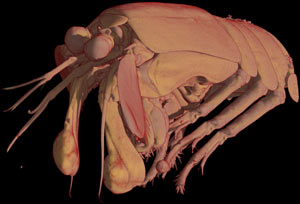Odontodactylus scyllarus, the peacock mantis shrimp, is beautifully colored with the greens, blues and pinks of a peacock. It lives in the warm waters of the Indo-Pacific and builds U-shaped burrows in gravel substrates. Odontodactylus scyllarus belongs to the Order Stomatopoda, which is a large and diverse clade of marine crustaceans. All stomatopods have specialized appendages for spearing or hammering prey. |
|
Peacock mantis shrimps use the rounded heel of their raptorial appendages to hammer prey, generating extraordinary forces. Recent studies have shown that they can produce forces that are thousands of times their body weight. In addition, their appendage moves through the water so quickly that the water vaporizes in a process called cavitation. The implosive collapse of these cavitation bubbles generates substantial forces that follow each hammer-strike.
Additional Anatomical Information
Click on the thumbnails below for labeled images of the specimen in standard anatomical views.

Literature
Ahyong, S. T. 1997. Phylogenetic analysis of the Stomatopoda (Malacostraca). Journal of Crustacean Biology 17:695-715.
Ahyong, S. T. and C. Harling. 2000. The phylogeny of the stomatopod crustacea. Australian Journal of Zoology 48:607-642.
Barber, P. H. and M. V. Erdmann. 2000. Molecular systematics of the Gonodactylidae (Stomatopoda) using mitochondrial cytochrome oxidase C (subunite 1) DNA sequence data. Journal of Crustacean Biology 20:20-36.
Burrows, M. 1969. The mechanics and neural control of the prey capture strike in the mantid shrimps Squilla and Hemisquilla. Zeitschrift fur vergleichende Physiologie 62:361-381.
Patek, S. N. and R. L. Caldwell. 2005. Extreme impact and cavitation forces of a biological hammer: strike forces of the peacock mantis shrimp (Odontodactylus scyllarus). Journal of Experimental Biology 208:3655-3664.
Patek, S. N., Korff, W. L., and R. L. Caldwell. 2004. Deadly strike mechanism of a mantis shrimp. Nature 428:819-820.
Links
Information and pictures of stomatopods on Roy's List of Stomatopods for the Aquarium (University of California Museum of Paleontology)











